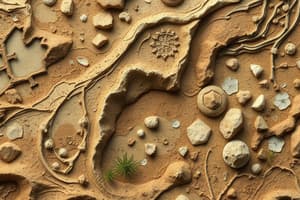Podcast
Questions and Answers
Which type of resource includes minerals deposits that are yet to be discovered or utilized?
Which type of resource includes minerals deposits that are yet to be discovered or utilized?
- Stocks
- Reserves
- Potential resources (correct)
- Developed resources
What is the distinguishing characteristic of non-renewable resources?
What is the distinguishing characteristic of non-renewable resources?
- They are always in abundant supply
- They consist of living organisms
- They can be replenished over time
- They are finite and cannot be replaced once consumed (correct)
Why is effective resource planning essential?
Why is effective resource planning essential?
- To deplete resources more quickly
- To exploit resources without monitoring
- To ensure unequal access to resources
- To promote sustainable use and equitable distribution of resources (correct)
What is the primary goal of conserving natural resources for future generations?
What is the primary goal of conserving natural resources for future generations?
Which category of resources includes air, water, minerals, coal, oil, and forests?
Which category of resources includes air, water, minerals, coal, oil, and forests?
What is the subset of stocks that are technically recoverable with current technology but have not been commercially developed called?
What is the subset of stocks that are technically recoverable with current technology but have not been commercially developed called?
What type of resources are infrastructure, buildings, vehicles, and machinery?
What type of resources are infrastructure, buildings, vehicles, and machinery?
Which type of resources include people's knowledge, skills, creativity, and abilities?
Which type of resources include people's knowledge, skills, creativity, and abilities?
What term is used to describe resources that originate from the biosphere?
What term is used to describe resources that originate from the biosphere?
In the context of resources, what does 'renewable' mean?
In the context of resources, what does 'renewable' mean?
Study Notes
Resources and Development
Resources and development is a critical aspect of societal progress, encompassing various forms of resources and strategies for utilizing them for economic advancement. This article explores the different types of resources and their classification, as well as the principles behind their development and conservation.
Forms of Resources
There are three broad categories of resources:
Natural Resources
Natural resources include everything found in nature, whether living (biotic) or not (abiotic), such as air, water, minerals, coal, oil, and forests. These resources are renewable if they can be replenished naturally over time or non-renewable, assuming they are finite and will eventually run out once extracted.
Human-Made Resources
These include infrastructure, buildings, vehicles, and machinery created by human labor. They are often considered as extensions of human capabilities, enabling easier access to and manipulation of natural resources.
Human Resources
Human resources refer to people themselves, including their knowledge, skills, creativity, and abilities. They play a crucial role in the development of societies and economies, contributing to the creation, management, and maintenance of resources.
Classification of Resources
Resources can be classified in various ways:
Based on Origin
Biotic resources originate from the biosphere and include living organisms, habitats, and ecosystems. Examples include plants, animals, fish, and forests. Abiotic resources do not have biological characteristics and consist of non-living elements such as earth, metals, and energy sources.
Based on Exhaustibility
Renewable resources can be replenished over time through natural processes or human intervention. Examples include solar energy, wind power, and forests. Non-renewable resources are finite and cannot be replaced once they are consumed. They include fossil fuels like coal, oil, and natural gas.
On the Basis of Status of Development
Potential resources refer to untapped reserves that have yet to be discovered or utilized, such as undeveloped mineral deposits or unexplored renewable energy sources. Developed resources are those that have been identified, assessed for quality and quantity, and are ready for extraction or use. Stocks are resources that exist but are not fully exploited due to technological limitations or other factors. Reserves are a subset of stocks that are technically recoverable with current technology but have not been commercially developed.
Resource Development and Planning
Effective resource development requires careful planning to ensure the sustainability and equitable distribution of resources. Key steps in resource planning include identifying and documenting available resources, creating a structured plan to develop these resources, complementing the plans with national initiatives, and monitoring and adapting the plans over time. Additionally, resource utilization and development planning aims to address challenges such as unequal access to resources between different regions or social groups within a country.
Conservation of Resources
Conserving natural resources for future generations is essential to maintain ecological balance and prevent long-term depletion. This involves implementing policies that promote sustainable use of renewable resources and protecting non-renewable resources from excessive exploitation. Technologies and practices should be developed to minimize waste and maximize efficiency in resource utilization.
In conclusion, understanding the various forms, classifications, and principles behind resource development is crucial for shaping environmentally sustainable economic growth and ensuring long-term prosperity. By carefully managing our resources, we can create a more equitable society while preserving the planet's rich natural endowments for future generations.
Studying That Suits You
Use AI to generate personalized quizzes and flashcards to suit your learning preferences.
Description
Explore the different types of resources, their classification, and the principles behind their development and conservation. Learn about natural resources, human-made resources, human resources, as well as the classification based on origin, exhaustibility, and status of development.




